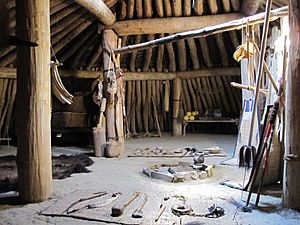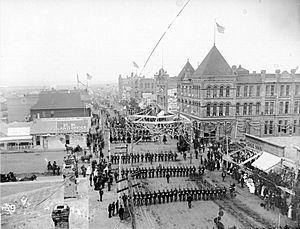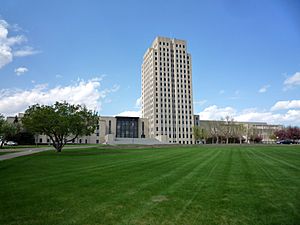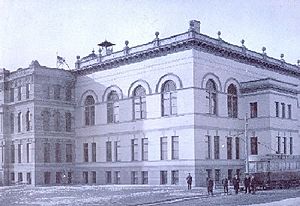History of Bismarck, North Dakota facts for kids
Bismarck is the capital city of North Dakota. It is also the main city in Burleigh County. After Fargo, Bismarck is the second largest city in North Dakota.
The city started in 1872. It was first called "Edwinton" after Edwin Ferry Johnson, a chief engineer for the Northern Pacific Railway. This was when the railroad reached the Missouri River. Less than a year later, the name changed to "Bismarck." This honored German leader Otto von Bismarck. The goal was to attract German people to move there. In 1874, gold was found nearby in the Black Hills. This helped the city grow a lot. In 1883, Bismarck became the capital of the Dakota Territory. Then, in 1889, it became the capital of the new state of North Dakota.
Contents
Ancient History: The Mandan People

People have lived in this area for thousands of years. These were Indigenous Americans. We don't know much about them before Europeans arrived. The first people we know a lot about were the Mandan Nation.
Today, you can visit Chief Looking's Village. This was one of their towns, and it's now a park in Bismarck. Other Mandan towns were near Bismarck too. These include On-a-Slant Village and Double Ditch Village. The Mandan people lived here from about the mid-1500s to the late 1700s. Their population was around 10,000 to 20,000 people. The Mandans were farmers and lived in special homes called earth lodges.
How Bismarck Began
The city of Edwinton was founded in 1872. This happened when the Northern Pacific Railway reached the Missouri River. The first buildings were at what is now Camp Hancock. This was a military post and supply center. It helped the railroad expand.
One year later, the city's name changed to "Bismarck." This was to honor the German leader Otto von Bismarck. In 1873, Burleigh County was formed. Bismarck became its main city. Soon, Bismarck grew quickly. It had a school, a courthouse, hotels, and stores. The Bismarck Tribune newspaper printed its first edition on July 11, 1873.
The railroad chose Bismarck as the place to cross the Missouri River. Bismarck was known as a wild town back then. But it was also seen as a beautiful place, full of peace and growth.
City Growth and the Railroad
Bismarck's future depended on the Northern Pacific Railway. The railroad faced money problems but kept going. After this, they started building a huge bridge over the Missouri River. It cost $1 million. The first passenger train crossed the Missouri in 1882. This brought a lot of new people and business to the area.
Around 1900
The 1890s were tough for many parts of the country, including North Dakota. A big economic problem called the Panic of 1893 hit the nation. North Dakota's economy, based on farming, was greatly affected.
Then, in August 1898, a big fire destroyed much of Bismarck. But the city soon began to rebuild. On May 14, 1889, a special meeting was held in Bismarck. This meeting, called the Constitutional Convention, led to the Dakota Territory becoming two states.
Rebuilding Bismarck After the Fire
After the 1898 fire, Bismarck had to rebuild a lot of its downtown. New buildings were made mostly of brick and concrete. They were often advertised as "fireproof." Two large, fancy hotels were built. The Hotel McKenzie, later called Patterson Hotel, opened in 1911. The Grand Pacific Hotel opened in 1912. These were Bismarck's biggest hotels for many years. Some U.S. presidents even stayed at the famous Patterson Hotel.
Liberty Memorial Bridge
In 1922, the first bridge for cars to cross the Missouri River was finished. This was the Liberty Memorial Bridge. It completed a major road, U.S. Highway 10, from one side of the country to the other. For many years, it was the only car bridge within 500 miles. Within two years, 2,000 cars were using the bridge every day.
More Businesses Come to Town
Bismarck continued to grow fast. Many of the nation's biggest stores came to the city. F.W. Woolworth arrived in the late 1910s. Montgomery Ward came in 1928, and J.C. Penney in 1929. Local stores were also doing well. These included Webb Brothers Department Store, which opened in 1884, and A.W. Lucas & Company, which opened in 1899.
The New State Capitol Building
On December 28, 1930, the old state capitol building was destroyed by fire. The damage cost $2 million. North Dakota had to build a new capitol during the Great Depression, a time when money was very scarce.
They chose to build a tall, modern skyscraper in the art deco style. It was 19 stories high when finished in 1934. It had a simple outside look but a very fancy inside design. People nicknamed it "The Prairie Palace." It was the tallest building in North Dakota for many years.
Building the Capitol: Challenges
Building the new capitol was not easy. Workers went on strike on May 13, 1933. The strike lasted for weeks. It only ended when Governor William Langer used special powers to make them stop.
When the capitol was finished in 1934, there was more news. Governor William "Wild Bill" Langer was removed from office. The North Dakota Supreme Court ordered him to leave. He was replaced by his Lieutenant Governor, Ole Olson.
A New High School is Built
By 1935, the old high school building from 1912 was too small. It had 634 students. So, Bismarck built a new Bismarck High School. This new building was expected to serve the growing city for many years. It was so big that it also housed Bismarck Junior College from 1939 to 1955.
Fort Lincoln During World War II
During World War II, Fort Lincoln Internment Camp was used as a special camp. It was located just south of Bismarck. The camp held German and Japanese civilians and prisoners of war. It was the largest such camp in the United States. By the time it closed in 1946, more than 4,030 people had been held there. The camp had started as a military post in 1895.
The Great Flood of 1952
On April 6, 1952, the Missouri River rose very high. It reached 27.9 feet. This caused the city's worst flood in 42 years. Almost everything south of the railroad tracks was underwater. Two hundred homes were destroyed. The Wachter family, who were ranchers, lost 300 cattle. The 1952 flood is still the biggest recent flood for Bismarck.
Garrison Dam Helps Control Floods
The Garrison Dam was completed in April 1953. This was one year after the big flood. The dam created Lake Sakakawea, which is the third largest man-made lake in the United States. For the first time, Bismarck could grow south of the railroad without fear of major floods. Local families, like the Wachter family, helped this growth. They bought land south of the tracks before the dam was finished.
Changes in Downtown Bismarck
Bismarck's first shopping center, Arrowhead Plaza, opened in 1954. Northbrook Mall, the city's second shopping center, opened in 1959. These malls started a new trend in how people shopped in the city.
For many years, downtown Bismarck was the main place for business. But things began to change. Interstate 94 was finished in 1965. This highway created a second bridge for cars, the Grant Marsh Bridge. The new highway moved all through-traffic away from downtown. This greatly affected downtown businesses, which used to rely on U.S. Highway 10 (Main Avenue).
Kirkwood Mall opened in 1970. This changed shopping in Bismarck forever. Woolworth's and Montgomery Ward were the first big stores to leave downtown and open at Kirkwood. Sears and A.W. Lucas moved to Gateway Mall when it opened in 1979. J.C. Penney was the last major department store to leave downtown. It moved to Kirkwood's new section in 1980. Since then, downtown Bismarck has faced challenges. The Bismarck Downtowner's Association was created to help support downtown businesses.
New Stores and Closures
Kmart was the first big discount store to arrive in Bismarck. It opened in October 1971. It was also one of the first businesses to open north of Interstate 94. Target came with Kirkwood's expansion in 1980. Wal-Mart opened in 1990.
Starting in the early 1980s, many long-time Bismarck businesses closed. A.W. Lucas closed soon after moving to Gateway Mall. Woolworth's closed in 1985. Gateway Mall was hit hard when White Mart closed in 1986. Kirkwood Mall also lost Montgomery Ward in 1998. Even with some store closures, Bismarck's business economy remained strong. New stores and restaurants continued to open.
Severe Weather Events
The early 2000s brought some of the worst storms to the Bismarck area. Just a few years earlier, the winter of 1996-1997 set a record for the most snowfall.
On November 1, 2000, several tornadoes touched down near the city. They caused only minor damage.
2001 Hailstorm
On June 9, 2001, a severe hailstorm hit Bismarck. It caused millions of dollars in damage. Almost every building in the city reported damage. The hail was as big as baseballs (1.5 inches). There was also a lot of rain and winds over 50 miles per hour. This storm led to the most insurance claims ever filed in North Dakota. It was even more than the Grand Forks Flood of 1997.
Winter of 2008–2009
The winter of 2008–2009 was one of the worst ever for Bismarck. December 2008 had the most snow for any single month. The whole winter season was the second snowiest on record. Bismarck also had a temperature of -44 °F. This was the coldest temperature since 1950.
2009 Floods
The record snowfall and very cold temperatures led to major spring flooding in 2009. It was the most severe flooding since 1952. To help lower the water levels, the water flow at the Garrison Dam was completely stopped for the first time ever. The flooding was mainly caused by ice jams in the Missouri River. Experts were brought in to break up the ice. This helped reduce the water levels. About 1,700 people had to leave their homes. Much of south Bismarck was flooded. A similar flood also happened in 2011.
Notable People
- John Moses





